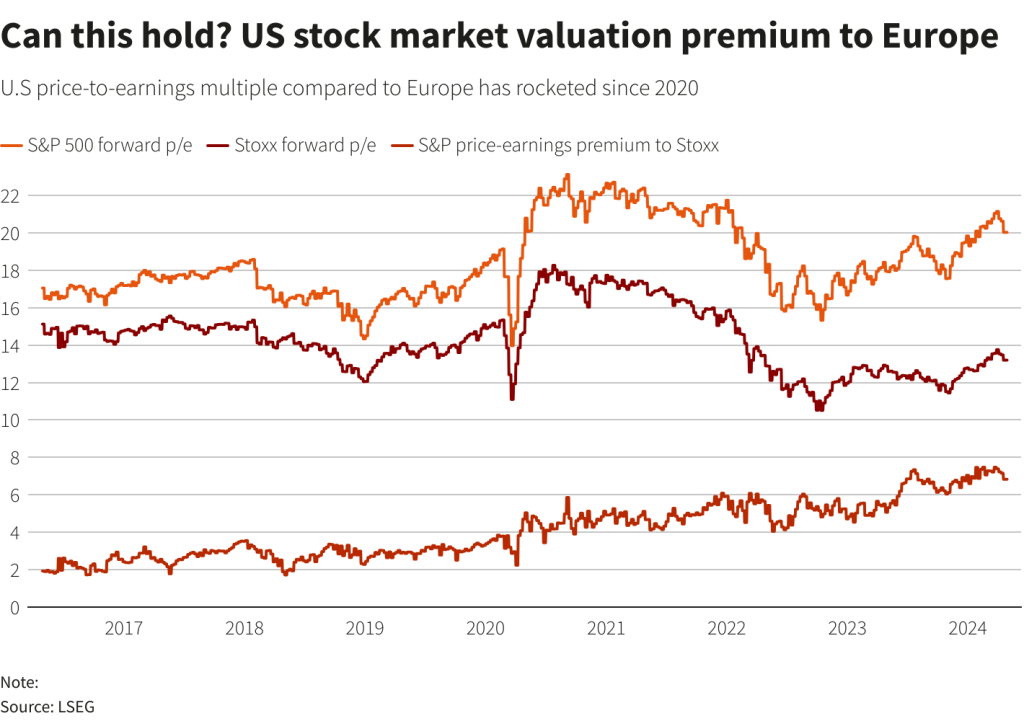Global investors are turning their attention towards European and emerging market assets as a strategy to shield themselves from ongoing volatility in U.S. stocks and bonds. This shift in focus comes amidst persistent inflationary pressures, prompting a reassessment of expectations regarding the timing of Federal Reserve interest rate adjustments.
The month of April proved challenging for Wall Street, with the S&P 500 share index and U.S. Treasuries experiencing their most significant monthly decline since September. As a result, money managers are actively exploring options to mitigate potential losses in case this trend persists without a reversal.
That could entail the restructuring of portfolios that had been lifted for years by richly-valued U.S. equities, said Sonja Laud, CIO at Legal & General Investment Management, which manages roughly $1.5 trillion.
“Diversification will be a lot more important going forward,” she said, adding that LGIM was not expecting superior returns from global stocks but now preferred European shares to those from the United States.
Amelie Derambure, senior multi-asset manager at Amundi, Europe’s biggest asset manager, said she still expected long-term gains from U.S. stocks but had bought put options to protect against a 10% fall. She had also switched some cash out of Treasuries into euro zone bonds.
The S&P 500 fell 4.2% in April.
ENTER EUROPE
U.S. stocks have provided about 80% of the price return of the MSCI World share index since 2020 in dollar terms, Pictet Asset Management calculates (.MIWO00000PUS)
The “Magnificent Seven” group of tech stocks, supercharged by an artificial intelligence boom, contributed over 60% of the S&P’s total return last year.
But as sticky inflation drives expectations that the Fed will hold U.S. borrowing costs at a 23-year high of 5.25%-5.5% or even hike again, the cost of betting on long-term gains from big tech’s hefty AI investments versus holding cash is rising.
A sharp fall in Facebook owner Meta’s (META.O), opens new tab shares in April highlighted the risks of hoping for stellar tech earnings in an environment where rates stay high. Until recently, markets had expected the Fed to start cutting in June.
The S&P remains highly valued, with a price-to-earnings multiple almost 7 percentage points above Europe’s Stoxx 600 (.STOXX), opens new tab, LSEG data shows.
Investors said the Stoxx appealed because it is stacked with companies in so-called value sectors such as banking and energy which benefit from steady global growth but tend not to suffer, opens new tab when borrowing costs rise.
“We are increasing exposure to Europe,” said Luca Paolini, chief strategist at Pictet Asset Management. “The general macro outlook is supportive for a cheap, cyclical value market.”
European fund manager Carmignac reduced some U.S. tech holdings in April and was seeking opportunities closer to home, the group’s head of cross-asset Frederic Leroux said.
“Diversifying towards Europe today makes a lot of sense,” he said. “Each time you have a new wave of (U.S.) inflation you will see a big outperformance for Europe.”
Moderating euro zone inflation means the European Central Bank is expected to start cutting interest rates on June 6.
Ross Yarrow, managing director for U.S. equities at investment bank Baird, said global investors were mostly negative on towards U.S. stocks on valuation grounds.
But superior revenue growth also helped Wall Street outpace Europe in 12 of the past 16 years, he said.

TREASURY BEARS
An index of Treasury bonds, (.MERG0Q0), dropped around 2% in April, its worst month since September.
Amundi’s Derambure said she still expected Fed cuts but had topped up on euro zone government bonds in recent weeks to wait “for this washout in U.S. fixed income to be over”.
Traders expect 35 bps of U.S. rate cuts this year but 65 bps in the euro zone, where inflation has dropped closer to the ECB’s 2% target.

According to Barclays strategists, Treasuries may not rally even when the Fed does cut because of high and rising U.S. government debt.
Emerging market bonds are picking up buyers, however, as investors hope to see robust economic growth in the likes of India, Indonesia and Vietnam.
LGIM’s Laud added that she was positive on Indian bonds, which have been snapped up by foreign investors ahead of inclusion in a major debt index later this year and as the economy booms.
“Within fixed income we see the best opportunities from a risk perspective (from) dollar-based emerging market debt,” Manulife’s chief investment officer for multi-asset solutions Nathan Thooft said.
TANGLED
Diversifying from U.S. assets could be tough.
The Stoxx tends to track the S&P, with an 88% correlation between the two markets since 1986, Baird’s Yarrow calculates.
Treasuries also strongly influence other debt markets, with a 1 percentage point rise in 10-year U.S. yields commonly pulling global yields 56 basis points higher, a Barclays study found.
“It is always very difficult to say, OK I want to be lighter on the U.S. and investing more in other parts of the world,” said Carmignac’s Leroux.
“But even with correlations, you have moments where you can find outperformance somewhere else.”

